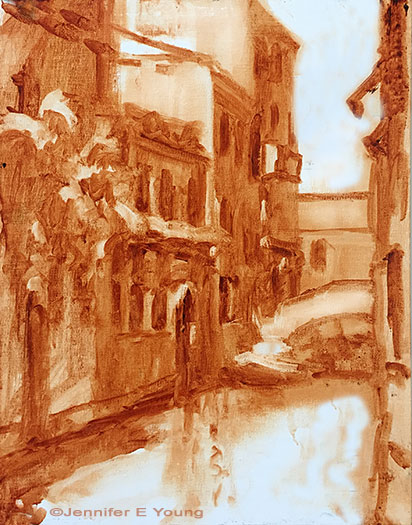Changing spaces (again)
/I mentioned in one of my recent posts that we are in the planning stages with a builder to build a new studio at our new residence. It's coming along-- I'm excited! 😃 But given that we are just in the permit stage, I know enough about building an art studio to know that it will be a while yet before that dream becomes a reality. Meanwhile, it will be important to save some money to help pay for the new digs. Sooo, I'm giving up my rental space and yet again, moving my studio.
This time I will attempt to work once more in the house. I feel like we have rearranged our house so many times in the year that we have lived here, that it's comical. So what's one or two times more, in the scheme of things? The room I've cleared out for my little temporary studio has been a catch-all room; a mud room, a temporary guest bedroom, and eventually it will be my office. It has a door that leads to the back screened porch and faces the site of the future studio. It sits a bit away from the rest of the house, and is just down the hallway from the garage. So in some ways, the location is ideal for a little painting space.
What's not ideal though, at ALL, is the lighting. This room is very, very dark, which is why I never thought to use it previously for a home studio. What's changed since we moved to Ashland though, is the easel light, shown below (installed on my Sorg easel, with an unfinished painting.)
The light is one by Revelite, which I learned of from seeing postings raving about it in several of my friends' Facebook feeds. Revelite makes traditional picture lights for lighting artwork, but also these work lights designed to work with artist's easels. They are slim profile, adjustable LED bulbs, with a high color rendering (CRI), purportedly, of over 90.
I purchased the 36" light. I will admit I was sweating bullets when I ordered this thing because while I was "pretty sure" this light would work with my easel, I still harassed Revelite's customer service for a few weeks with a barrage of inquisitive emails. It was, after all, a very expensive light. And it carried a hefty restocking fee in the event it needed to be returned. Luckily, though, the light mounted to my easel without an issue, and I am really pleased with the quality of the light it provides to my painting surface.
Above is my new home-based temporary studio! Although I still think I need more light for the room, at least I have lit the most important parts of my workspace in order to get the job done. I've lit the palette area with a standing Ott-lite for now, but as you can see this is a very cold, bluish light compared to the warmer but still very clean easel light (which I prefer.) I am still working on a better solution to this problem, because putting different lighting on my painting and palette will likely be problematic.
If this little space is looking quite neat, it's because the rest of my supplies (frames, equipment, paintings, etc) are stashed in a million different places throughout my house, with even more still at the rental space. All of that stuff will need to be moved out and consolidated and organized by the end of August, so aside from painting and splashing in the water with the kiddo, you can guess how I will be spending a good part of the rest of my summer!




















